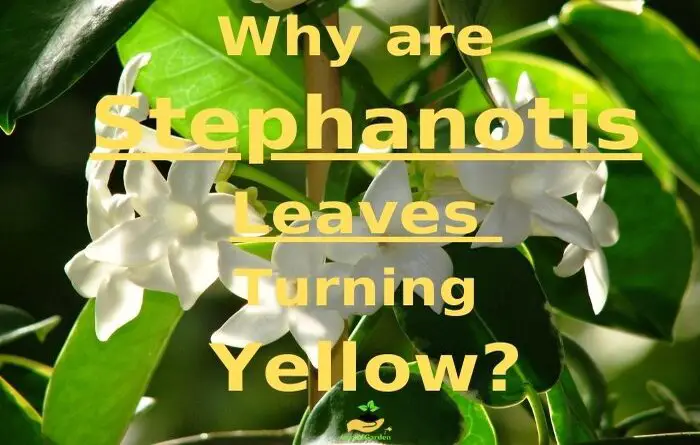Why are Stephanotis Leaves Turning Yellow? [5 Common Reasons]
Stephanotis is a popular choice for home gardeners because it’s easy to grow, it blooms early in spring and it’s very attractive but if the leaves are turning yellow you need to take measures!
There are a variety of reasons why your stephanotis leaves are turning yellow. The first thing you should do is check the condition of your plants to see if there is any other problems that may have caused this issue. If so, you can treat them separately.
Stephanotis leaves turn yellow due to many factors, including: overwatering, nutrient deficiency, lack of sunlight, too much sun exposure, pests and diseases. Stephanotis plants can become stressed by overfertilizing them with fertilizer or watering them too often, so they will start to wilt and turn yellow.
| Causes why Stephanotis Leaves Turn Yellow |
|---|
| 1. Overwatering (Waterlogging) |
| 2. Lack of light |
| 3. Nutrients deficiency |
| 4. Low humidity |
| 5. Disease and pests |
Causes why Stephanotis Leaves Turn Yellow
1. Overwatering
Overwatering is a common cause of yellowing leaves for stephanotis. Especially for potted plants like stephanotis because it disrupts the function of the roots, due to which the leaves ceases to receive the required amount of nutrition and as a result, the leaves begin to turn yellow and dry out.
Stephanotis plants usually do not require much water, especially if you are using the soil-less potting mix.
However, if there is not enough room for them to grow properly in their pots, you may need to water them more often than usual.
This is especially true if you don’t have good drainage in your soil. Make sure your soil is well drained, and avoid over-watering your stephanotis plants.
Stephanotis plants should be watered so that the top inch or two of soil gets wet at least once every week or two. If you do not see any signs of wilting or yellowing on your stephanotis leaves before watering, then you may need to re-pot your stephanotis plant in order for it to receive enough water.
Always wait until the substrate is dry on the surface before watering. Do not leave stagnant water in the stephanotis saucers: they do not like to have their roots submerged in water.
Then check the roots: if they are not rotten, repot the plant by replacing the soil with a new one.
2. Lack of light
Yellow leaves can be caused by many different things, but the second common cause is the lack of light they receive during the day time which decreases the production of chlorophyll in the stephanotis leaves. This can be caused by too much shade, or not enough light for the plant to grow properly.
If you notice that your stephanotis plants do not get any sunlight at all during these hours, make sure you have good lighting and a temperature that is not too hot or too cold.
It is also important that you keep an eye on your stephanotis plant because if it gets too dry its leaves will turn yellow.
In conditions of insufficient lighting, shoots stretch and thin, leaves practically do not grow, so the plant should not be kept in the shade, and in winter additional artificial lighting is required up to 10-12 hours.
Fortunately, this cause is quite easy to eliminate: just move the pot to a sunny windowsill or place the stephanotis under a fluorescent lamp.
Excess of Light (Sunburn)
Another common reason for yellowing leaves on a stephanotis is too much sun exposure. Excess light leads to sunburn, when the leaves and other parts of the plant become covered with yellow and black spots.
Planting your stephanotis in full sun will likely cause them to turn yellow and fall off soon after they bloom. This is especially true if you have planted them too deep or have allowed them to dry out before they bloom.
In this case, the leaf does not turn yellow, but immediately turns brown. And not completely, but in zones or even pointwise. You need to know more about a stephanotis as a plant and its ability to withstand direct sunlight.
Rotate the stephanotis pot from time to time so that all parts of the plant receive enough light.
If you have a sunny windowsill and the plant does not get enough water, the leaves will turn yellow.
3. Nutrients deficiency
A lack of nutrients in the soil is another likely cause why stephanotis leaves turn yellow.
A substrate with adequate nutrients for the type of plant we have is essential to keep them healthy and with the green that characterizes them.
The lack of iron, phosphorus or nitrogen in the soil on which the plant feeds may cause chlorosis.
Chlorosis is induced by the disappearance of chlorophyll (which is responsible for the green color of the leaves), begins at the edge of the leaves, turning them yellow and extends towards the leaf veins, which remain green.
The deficiency of nutrients manifests itself in different ways:
| Symptoms of Stephanotis Leaves | Nutrients deficiency | How to Treat |
|---|---|---|
| 1. Leaves become smaller and turn yellow | Lack of nitrogen | Mulch the soil with compost or coffee grounds to help balance out the nitrogen levels. |
| 2. Leaves are covered with yellow spots | Lack of magnesium | Apply fertilizers rich in magnesium. |
| 3. Leaf plates become yellowish-gray | Lack of manganese | Apply manganese sulfate fertilizer. |
| 4. Leaf turns yellow down to the leaf veins | Lack of iron | Apply ferrous sulfate fertilizer. |
4. Low humidity
In this case, the signs are similar to those that occur with insufficient watering. The plant withers, the tone drops, the leaves turn yellow and fall. It is necessary to increase the humidity of the air.
We have repeatedly written and once again we will remind you: 50% humidity is enough for most plants. In ordinary panel houses, there is no such humidity. Therefore, it must be artificially created by air humidifiers .
Stephanotis have been exposed to a period of prolonged dry weather. If this has occurred in the winter months, when plants are dormant, the leaves may turn yellow as they recover from their dormancy.
Regular watering will help correct the situation (at least 0.5 liters of water per week at the bottom of the plant).
The temperature of your stephanotis soil should be between 10°C to 28°C (50°F to 82°F). If the temperature drops below 10°C (50°F) , then you should water your plant regularly so that the soil remains moist but not wet.
If the temperature rises above 28°C, then you should water your plant less frequently and only when it gets dry enough for its leaves to turn yellow or brownish-yellow in appearance.
5. Disease and pests
Stephanotis plants are susceptible to a number of diseases and pests that can cause yellow leaves. The most common diseases of the Stephanotis are:
- Anthracnose (a fungus disease)
- Black spot (a fungal disease)
- Fusarium wilt, also known as root rot
- Fungal pathogens
The leaves on your stephanotis are turning yellow because of a disease called leaf spot. The most common cause is overwatering, which can cause the roots to rot and then the leaves to fall off.
The most common reason for stephanotis plant leaves to turn yellow is the fungal disease known as anthracnose. Anthracnose causes the leaves to turn yellow, but it does not kill the plant. In fact, anthracnose is one of the best ways to keep a stephanotis plant healthy.
Anthracnose can be controlled with fungicide sprayings and pruning out infected leaves. If you see signs of infection on your stephanotis plants leaves, prune them off immediately to prevent further spread of the disease.
Insect pests
Another reason why the leaves on my stephanotis are turning yellow could be due to mites or aphids infestation in your garden soil which cause damage to your plants leaves and increase their susceptibility towards fungal infection.
Insects like aphids or whiteflies will often leave dark spots on the leaves, which may turn yellow as they dry out and die. You may also see leaf drop from these pests as well as from mealybugs and scale insects.
An insect infestation can cause yellowing of leaves on your stephanotis plant. Insects such as aphids, whiteflies and thrips feed on foliage and leave behind honeydew that causes discoloration on the leaves.
Conclusion
Stephanotis plant is a beautiful, but very sensitive plant. It requires careful attention and care to grow to its full potential.
The first thing you should do is check the condition of your plants to see if there is any other problems that may have caused this issue. If so, you can treat them separately.




